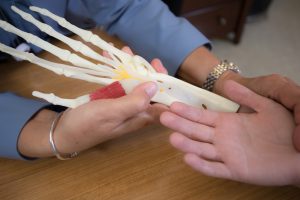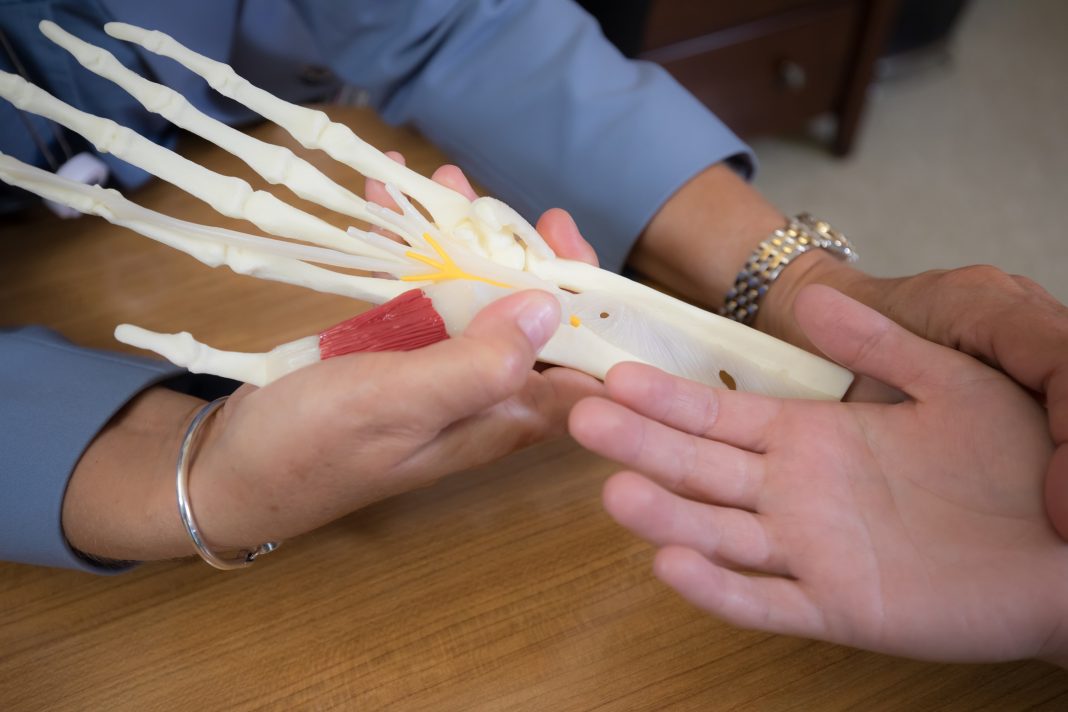The human hand is a profoundly important and extremely delicate instrument. Like any other part of the human body, it’s subject to wear, tear, and injuries that restrict functionality and negatively impact your life. Whether you’re suffering from arthritis, carpal tunnel syndrome, or a variety of other hand- or wrist-related conditions, the surgical team at the PeaceHealth Surgery & Orthopedics Center in Sedro-Woolley can help.

Doctor Kaärsten Lang has been an orthopedic surgeon for nearly 30 years, with an emphasis on hand surgeries. She joined PeaceHealth in September 2016, bolstering a team of highly trained, board-certified surgeons who are always up-to-date on the latest evidence-based medical information.
Lang expertly treats carpal tunnel syndrome,trigger finger, arthritis, wrist tendonitis, and Dupuytren’s contracture, among other conditions. Most of these issues tend to occur in patients middle-aged and older, she says, though other conditions and sports-based injuries can happen at younger ages.
Getting a Grip on Carpal Tunnel
Carpal tunnel syndrome commonly causes pain, numbness and tingling in the hand. It happens because of narrowing of a passageway in the wrist called the carpal tunnel, which squeezes the median nerve traveling through the wrist. Early treatment involves wearing a wrist splint or avoiding certain activities, but lack of treatment can cause permanent nerve damage. Eventually, surgery should be considered if symptoms don’t improve.
“It’s time for surgery when you start having numbness, such as your hand falling asleep at night, or if it’s going numb multiple times a day; certainly, if it’s constantly numb,” Lang says. “Sometimes patients will start losing dexterity and their ability to manipulate small objects like small buttons, coins, or jewelry. A lot of times, older patients will misinterpret painful numbness as arthritis and put up with the pain, when they have a condition that’s easily treated.”
Risk factors for carpal tunnel syndrome include heredity, health conditions like diabetes, being overweight, repetitive use, and extreme hand or wrist extension or flexion.
Most surgeries for carpal tunnel and other orthopedic conditions only take between 5 and 15 minutes, and are outpatient procedures requiring only local or regional anesthesia. Surgery prep is often as long as the procedures themselves, Lang says. Recovery time is usually one to two weeks before stitches come out, and most patients should be able to use their hands normally after that, she adds. While most people don’t require it, post-surgical hand therapy is also available. “After carpal tunnel surgery, it’s not uncommon to have a little tenderness with gripping, pushing and pulling activities, but it’s generally not incapacitating,” Lang says.
Releasing Trigger Finger
Trigger finger is another common condition, where a finger becomes stuck in a bent position. This causes pain, stiffness and a sensation of locking or catching in affected fingers, usually in the ring finger or thumb. The condition happens when a band of tissue at the base of a finger—called the A1 pulley— becomes inflamed, making flexor tendon movement difficult. Trigger finger can be common in those with rheumatoid arthritis. Rest, splints and steroid injections are all treatment options, but surgery is sometimes needed. The procedure opens the A1 pulley that’s blocking tendon movement, allowing the flexor tendon—and thus, your finger—to move more normally.

Easing Arthritis
Arthritis is the inflammation of joints in the hand or wrist. Without treatment, the bones that make up joints can lose normal shape, causing pain and limitation of motion. There are many medications and non-surgical treatments, but again, sometimes surgery is needed. If it is, there are several surgical options for arthritis. These include preserving or reconstructing the involved joints, or replacing them altogether with artificial ones.
Slowing Dupuytren’s Contracture
Dupuytren’s contracture is where the fibrous layer of tissue beneath the skin of the palm and fingers slowly thickens and tightens. This pulls the fingers towards the palm. Its cause isn’t fully understood. Dupuytren’s can usually be treated with injections and non-surgical treatments, and progresses very slowly. But for more severe cases where hand function is impacted, surgery can help improve finger motion and slow the condition down.
Helping Hand Injuries
Then there are sports or work-related injuries. These include ligament stretches, finger tears, thumb injuries, finger sprains and dislocations, and fractures caused by a variety of unfortunate incidents. The orthopedic surgeons at PeaceHealth have seen them all.
“We’re happy to see you if you’re not sure if you need to be seen,” Lang says. “We’re happy to help you come to a decision on whether further treatment is necessary.”
Unlike surgeries on other areas of the body, Lang says hand and wrist-related orthopedic procedures are particularly rewarding to her, because taking pressure off a nerve or strengthening a bent finger is so clear-cut. “So much of what we do has an immediate, positive result,” she says. “That’s really quite gratifying.”
If you have a hand or wrist issue, a stop at PeaceHealth Surgery & Orthopedics Center in Sedro-Woolley may be your best bet on figuring out what to do next. Visit the PeaceHealth Surgery & Orthopedics Center website or call 360-856-6021 to learn more.
Sponsored




































